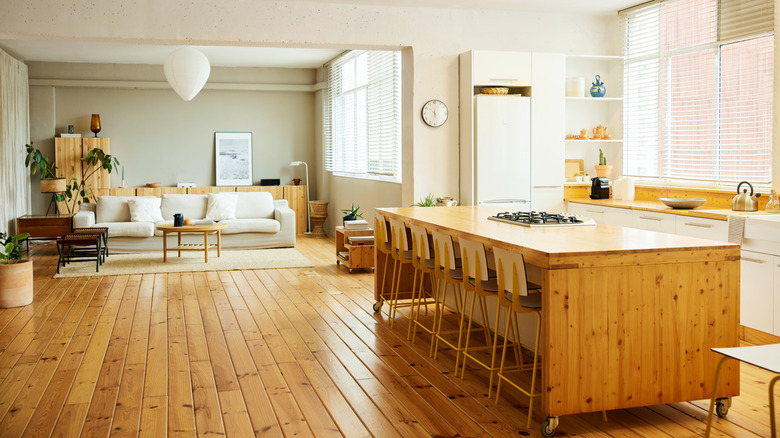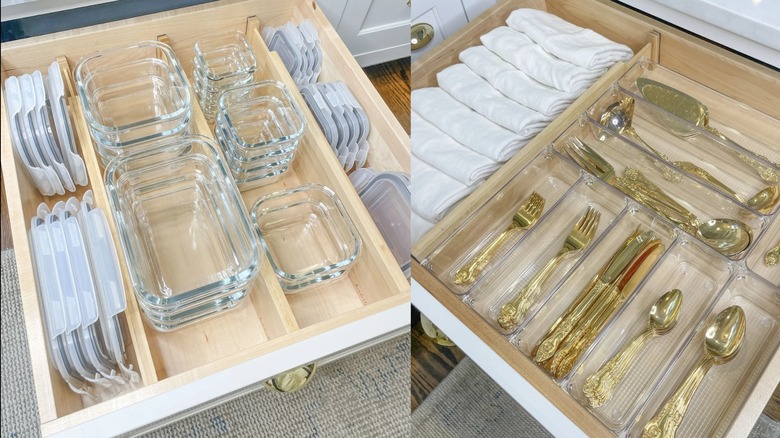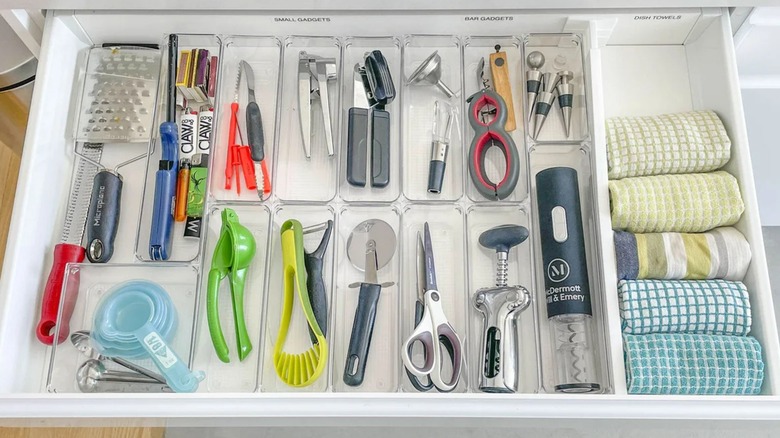You're Not Using Your Kitchen Island Drawers Right, Here's What To Store
Kitchen islands can be a godsend for their addition of storage as well as counter space. There are plenty of sleek kitchen island designs that will take your space to new heights and add an elegant look and feel by having more exposed countertops and even room for additional appliances. From a coffee bar or ice maker, there are so many ways to optimize your island to make your kitchen feel all the easier to cook in. But, if you're using your kitchen island solely for the countertops and not as a budget-friendly way to organize your kitchen, then you're missing out. By using simple hacks like categories and labels, you can use your kitchen island drawers the right way and have a seamless kitchen storage system.
We spoke with Jamie Hord, the founder of Horderly Professional Organizer, to gather her tips on how to use kitchen island drawers the right way. Her first tip is pretty comforting to anyone who feels like their kitchen island drawers are a miscellaneous storage area. When asked what people should not store in their kitchen drawers, Hord assured us that "there isn't much, if anything, that we would suggest not to organize in a drawer." Of course, there are the obvious choices that should be a go-to. "Depending on the layout and flow of your kitchen, kitchen island drawers can hold anything from utensils, Tupperware, wraps and baggies, kitchen gadgets, mixing bowls, and strainers," Hord said. However, that doesn't mean you're limited to those things.
How to organize your drawers correctly
Although there's no limit to what you should store in the kitchen (other than the obvious size limitations), expert Jamie Hord said that "there are, however, categories that trump others of what gets first priority for a drawer." In her exclusive interview with House Digest, Hord laid out the steps of properly organizing your things in order to get the most out of your kitchen drawers. "First you'll want to pull out/sort and declutter everything in your kitchen," she said. That means emptying out the drawers that are already full, even if it feels counterproductive. Once you can see all of your stored objects, you'll have a clearer picture of the categories of things that are housed in your kitchen island, and this will make packing the drawers much easier.
"You'll then want to strategize the space to figure out what you want to live in the drawer," Hord said. That means removing those extra batteries, rubber bands, broken utensils, and other clutter to decide what actually belongs in the kitchen island and what should find a home elsewhere. Sort the items you want in your kitchen island into categories like silverware, Tupperware, and so on. Then, you'll want to purchase some simple organizer trays that are perfectly fit to your drawers. "Measure the drawer to find the proper solutions to bring in organizers and structure like individual drawer organizers or expandable drawer dividers," Hord said.
Common mistakes people make
Organizing expert Jamie Hord exclusively told House Digest that there are plenty of mistakes she sees people make when it comes to organizing their kitchen island drawers. Three big ones are "not creating clear zones/categories, not using the proper organizers or structure, [and] not labeling so that everyone in the household knows where to find something and where to put it back," Hord said. Therefore, you should take your time on the categorization piece of the process so that you really have a handle on what's being stored in your drawers. It's also important to invest in the right organizers so that your kitchenware isn't combining into one big messy pile every time a drawer opens and closes. Finally, a label maker can be your best friend here. If you have multiple cooks in your kitchen, you should label your organization system so everyone knows where things are stored.
Hord's final major tip was, "Consider that you might need to look at the entire space as a whole rather than a drawer individually." That means that each drawer shouldn't be treated as a separate entity, but in fact, should be a part of the bigger picture. Having similar kitchen items in similar locations is imperative to the cooking and cleaning process, and random other categories could get in the way of keeping your kitchen easy to use. "You might need to move categories to other locations in order to balance everything out," Hord advised.


